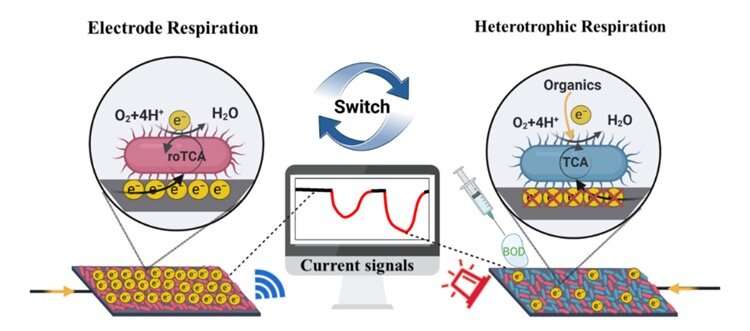This article has been reviewed according to Science X's editorial process and policies. Editors have highlighted the following attributes while ensuring the content's credibility:
fact-checked
proofread
Research team realizes rapid detection of low-concentration BOD in an oxygen-rich water environment

Researchers at the College of Environmental Science and Engineering of Nankai University have introduced a new strategy to realize rapid biochemical oxygen demand (BOD) measurement by using the competitive switching of electrotrophic and heterotrophic pathways of facultative bacteria. The findings were published in Water Research under the title "Switchover of Electrotrophic and Heterotrophic Respirations Enables the Biomonitoring of Low Concentration of BOD in Oxygen-rich Environment."
The research team isolated and obtained a strain of Acinetobacter venetianus RAG-1 with both electrotrophic and heterotrophic respiration from microbial electroactive biofilms (EABs) over a period of five years. The findings of research reveal that this bacterium can respire with a polarized graphite electrode in the absence of a degradable organic carbon source, and the current generated at this point can be used as the baseline of sensors.
When degradable pollutants are present in the water, RAG-1 swiftly switches to heterotrophic respiration, resulting in a decrease in current. The decrease in current value is proportional to the concentration of organic pollutants. Based on this, the research team developed a novel bio-cathode BOD sensor, which has a linear response to common pollutants such as organic acids, sugars, proteins, humic acids, as well as mixtures such as low-concentration domestic sewage and lake sediments. It realizes sensitive monitoring of oxygen-rich and low-BOD water, with a test time of less than three hours.
This study further explains the switchover mechanism of facultative electrotrophic bacteria's metabolic pathways and their adaptability and resilience to contaminated environment. Based on this new principle, the research team will develop more electrotrophic-heterotrophic microorganisms as sensing elements to support rapid BOD monitoring under complex environmental scenarios. This technique is expected to be used in water quality regulation for aquaculture, water quality monitoring for reclaimed water, and more.
More information: Yilian Han et al, Switchover of electrotrophic and heterotrophic respirations enables the biomonitoring of low concentration of BOD in oxygen-rich environment, Water Research (2023). DOI: 10.1016/j.watres.2023.119897
Provided by Nankai University





















